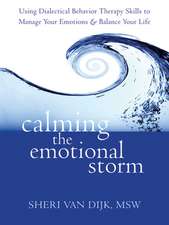Crying in the Middle Ages: Tears of History: Routledge Studies in Medieval Religion and Culture
Editat de Elina Gertsmanen Limba Engleză Paperback – 8 noi 2013
Gertsman brings together essays that establish a series of conversations with one another, foregrounding essential questions about the different ways that crying was seen, heard, perceived, expressed, and transmitted throughout the Middle Ages. In acknowledging the porous nature of visual and verbal evidence, this collection foregrounds the necessity to read language, image, and experience together in order to envision the complex notions of medieval crying.
| Toate formatele și edițiile | Preț | Express |
|---|---|---|
| Paperback (1) | 491.17 lei 6-8 săpt. | |
| Taylor & Francis – 8 noi 2013 | 491.17 lei 6-8 săpt. | |
| Hardback (1) | 1067.14 lei 6-8 săpt. | |
| Taylor & Francis – 21 oct 2011 | 1067.14 lei 6-8 săpt. |
Preț: 491.17 lei
Nou
Puncte Express: 737
Preț estimativ în valută:
93.99€ • 97.11$ • 78.19£
93.99€ • 97.11$ • 78.19£
Carte tipărită la comandă
Livrare economică 19 martie-02 aprilie
Preluare comenzi: 021 569.72.76
Specificații
ISBN-13: 9780415744195
ISBN-10: 0415744199
Pagini: 350
Ilustrații: 29 black & white halftones
Dimensiuni: 152 x 229 x 20 mm
Greutate: 0.5 kg
Ediția:1
Editura: Taylor & Francis
Colecția Routledge
Seria Routledge Studies in Medieval Religion and Culture
Locul publicării:Oxford, United Kingdom
ISBN-10: 0415744199
Pagini: 350
Ilustrații: 29 black & white halftones
Dimensiuni: 152 x 229 x 20 mm
Greutate: 0.5 kg
Ediția:1
Editura: Taylor & Francis
Colecția Routledge
Seria Routledge Studies in Medieval Religion and Culture
Locul publicării:Oxford, United Kingdom
Public țintă
Postgraduate and UndergraduateCuprins
Contents Preface: ‘Going They Went and Wept’: Tears in Medieval Discourse, Elina Gertsman Introduction: Considerations of Weeping and Sincerity in the Middle Ages, Lyn A. Blanchfield Part I: Tears and Image 1: Women Mourners in Byzantine Art, Literature, and Society, Henry Maguire 2: The Eve Fragment from Autun and the Emotionalism of Pilgrimage, Marian Bleeke 3: Weeping Women: Social Roles and Images in 14th century Tuscany, Judith Steinhoff 4: The Paradoxical Rhetoric of Tears: Looking at the Madrid Descent from the Cross, Felix Thürlemann Part II: Tears and Religious Experience 5: A Penitent Prepares: Affect, Contrition, and Tears, Christopher Swift 6: He Cried and Made Others Cry’: Crying as a Sign of Pietistic Authenticity or Deception in Medieval Islamic Preaching, Linda G. Jones 7: Si puose calcina a’ propi occhi: The Importance of the Gift of Tears for Thirteenth-Century Religious Women and their Hagiographers, Kimberley-Joy Knight 8: Weeping as Discourse Between Heaven and Earth: The Transformative Power of Tears in Medieval Jewish Literature, Rachel S. Mikva Part III: Tears and Narrative 9: The Shedding of Tears in Late Anglo-Saxon England, Tracey-Ann Cooper 10: Tears and Trial: Weeping as Forensic Evidence in Piers Plowman, Katherine O'Sullivan 11: A Sorrowful Song: On Tears in Chrétien de Troyes’s Philomena, Irit Kleiman 12: Crying in Public and in Private: Tears and Crying in Medieval German Literature, Albrecht Classen Conclusion: Transmitting Despair by Manuscript and Print, Barbara H. Rosenwein
Descriere
Sacred and profane, public and private, emotive and ritualistic, internal and embodied, medieval weeping served as a culturally charged prism for a host of social, visual, cognitive, and linguistic performances. Crying in the Middle Ages addresses the place of tears in Jewish, Christian, and Islamic cultural discourses, providing a key resource for scholars interested in exploring medieval notions of emotion, gesture, and sensory experience in a variety of cultural contexts.
Gertsman brings together essays that establish a series of conversations with one another, foregrounding essential questions about the different ways that crying was seen, heard, perceived, expressed, and transmitted throughout the Middle Ages. In acknowledging the porous nature of visual and verbal evidence, this collection foregrounds the necessity to read language, image, and experience together in order to envision the complex notions of medieval crying.
Gertsman brings together essays that establish a series of conversations with one another, foregrounding essential questions about the different ways that crying was seen, heard, perceived, expressed, and transmitted throughout the Middle Ages. In acknowledging the porous nature of visual and verbal evidence, this collection foregrounds the necessity to read language, image, and experience together in order to envision the complex notions of medieval crying.


























